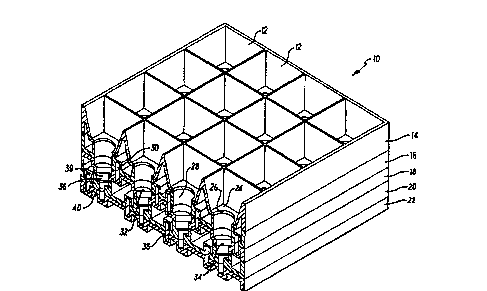Some of the information on this Web page has been provided by external sources. The Government of Canada is not responsible for the accuracy, reliability or currency of the information supplied by external sources. Users wishing to rely upon this information should consult directly with the source of the information. Content provided by external sources is not subject to official languages, privacy and accessibility requirements.
Any discrepancies in the text and image of the Claims and Abstract are due to differing posting times. Text of the Claims and Abstract are posted:
| (12) Patent Application: | (11) CA 2184080 |
|---|---|
| (54) English Title: | MICROWAVE ANTENNAS |
| (54) French Title: | ANTENNES HYPERFREQUENCE |
| Status: | Deemed Abandoned and Beyond the Period of Reinstatement - Pending Response to Notice of Disregarded Communication |
| (51) International Patent Classification (IPC): |
|
|---|---|
| (72) Inventors : |
|
| (73) Owners : |
|
| (71) Applicants : | |
| (74) Agent: | SMART & BIGGAR LP |
| (74) Associate agent: | |
| (45) Issued: | |
| (86) PCT Filing Date: | 1995-02-24 |
| (87) Open to Public Inspection: | 1995-08-31 |
| Examination requested: | 2002-02-21 |
| Availability of licence: | N/A |
| Dedicated to the Public: | N/A |
| (25) Language of filing: | English |
| Patent Cooperation Treaty (PCT): | Yes |
|---|---|
| (86) PCT Filing Number: | PCT/GB1995/000398 |
| (87) International Publication Number: | WO 1995023440 |
| (85) National Entry: | 1996-08-23 |
| (30) Application Priority Data: | |||||||||
|---|---|---|---|---|---|---|---|---|---|
|
A microwave antenna (10) is formed from a stack of generally planar elements (14-22) forming an array of horns (12) communicating
with waveguides (38). The generally planar elements (14-22) are of metallised plastics. Each of these elements (14-22) has a given overall
thickness which is constituted by a membrane of relatively small thickness formed (typically by vacuum forming) into a corrugated shape.
Selon l'invention, on forme une antenne hyperfréquence (10) à partir d'une pile d'éléments (14-22) généralement plans formant un réseau d'éléments en forme de cornets communiquant avec les guides d'ondes (38). Ces éléments (14-22) sont en plastique métallisé et présentent chacun une épaisseur globale constituée par une membrane d'épaisseur relativement faible, dotée (généralement par formation sous vide) d'une configuration ondulée.
Note: Claims are shown in the official language in which they were submitted.
Note: Descriptions are shown in the official language in which they were submitted.

2024-08-01:As part of the Next Generation Patents (NGP) transition, the Canadian Patents Database (CPD) now contains a more detailed Event History, which replicates the Event Log of our new back-office solution.
Please note that "Inactive:" events refers to events no longer in use in our new back-office solution.
For a clearer understanding of the status of the application/patent presented on this page, the site Disclaimer , as well as the definitions for Patent , Event History , Maintenance Fee and Payment History should be consulted.
| Description | Date |
|---|---|
| Inactive: IPC from MCD | 2006-03-12 |
| Application Not Reinstated by Deadline | 2005-02-24 |
| Time Limit for Reversal Expired | 2005-02-24 |
| Inactive: Abandoned - No reply to s.30(2) Rules requisition | 2004-02-26 |
| Deemed Abandoned - Failure to Respond to Maintenance Fee Notice | 2004-02-24 |
| Inactive: S.30(2) Rules - Examiner requisition | 2003-08-26 |
| Letter Sent | 2002-04-19 |
| Inactive: Application prosecuted on TS as of Log entry date | 2002-04-19 |
| Inactive: Status info is complete as of Log entry date | 2002-04-19 |
| Request for Examination Requirements Determined Compliant | 2002-02-21 |
| All Requirements for Examination Determined Compliant | 2002-02-21 |
| Inactive: Entity size changed | 2002-02-12 |
| Amendment Received - Voluntary Amendment | 1996-11-20 |
| Application Published (Open to Public Inspection) | 1995-08-31 |
| Abandonment Date | Reason | Reinstatement Date |
|---|---|---|
| 2004-02-24 |
The last payment was received on
Note : If the full payment has not been received on or before the date indicated, a further fee may be required which may be one of the following
Please refer to the CIPO Patent Fees web page to see all current fee amounts.
| Fee Type | Anniversary Year | Due Date | Paid Date |
|---|---|---|---|
| MF (application, 3rd anniv.) - small | 03 | 1998-02-24 | 1998-02-09 |
| MF (application, 4th anniv.) - small | 04 | 1999-02-24 | 1999-02-02 |
| MF (application, 5th anniv.) - small | 05 | 2000-02-24 | 2000-02-21 |
| MF (application, 6th anniv.) - small | 06 | 2001-02-26 | 2001-01-31 |
| MF (application, 7th anniv.) - standard | 07 | 2002-02-25 | 2002-02-04 |
| Request for examination - standard | 2002-02-21 | ||
| MF (application, 8th anniv.) - standard | 08 | 2003-02-24 | 2003-02-06 |
| MF (application, 2nd anniv.) - small | 02 | 1997-02-24 |
Note: Records showing the ownership history in alphabetical order.
| Current Owners on Record |
|---|
| FORTEL TECHNOLOGY LIMITED |
| Past Owners on Record |
|---|
| JOHN LOUIS FREDERICK CHARLES COLLINS |